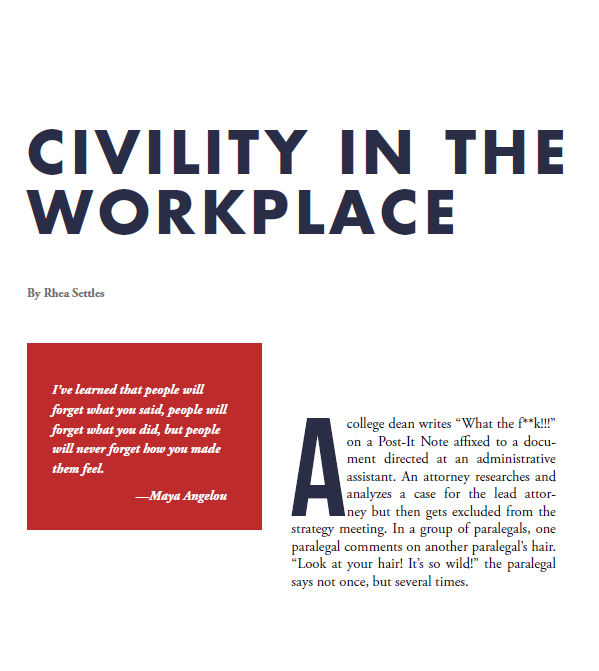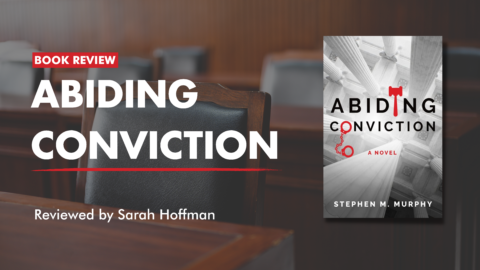“I’ve learned that people will forget what you said, people will forget what you did, but people will never forget how you made them feel.”
—Maya Angelou

A college dean writes “What the f**k!!!” on a Post-It Note affixed to a document directed at an administrative assistant. An attorney researches and analyzes a case for the lead attorney but then gets excluded from the strategy meeting. In a group of paralegals, one paralegal comments on another paralegal’s hair. “Look at your hair! It’s so wild!” the paralegal says not once, but several times.
Imagine how you would feel if you were on the receiving end of this conduct in your workplace. Imagine needing to address it but not knowing how, and feeling unsafe if you did. These types of harmful experiences are not uncommon; they occur every day in the workplace. Further, there are few workplace resources available to address this type of conduct. It is often ignored and dismissed by decision-making employees (commonly known as managers or leaders). When mistreated employees complain, they can find themselves professionally unsafe, their spirit wounded, and career killed. Their life is diminished.
Getting relief from abusive conduct and mistreatment in the workplace is challenging because often the standard remedies don’t apply. Employees can’t turn to Title VII of the Civil Rights Act; other laws against discrimination, sexual harassment or hostile work environment; the Public Employment Relations Board (PERB); the National Labor Relations Board (NLRB); union collective bargaining agreements; labor codes; or even their own human resources department. This leaves the employee to suffer in silence or escalate to a workplace conflict war.
A workplace conflict war is an all-out battle between the mistreated employee against the employee doing the mistreating, bystander employees, workplace attorneys, and the employer. To seek relief, the mistreated employee tries to fit the situation into one of the remedy sources listed above and ends up settling for a small monetary sum in exchange for leaving the job and agreeing not to disclose what happened. Meanwhile, the employee abusive conduct and mistreatment issue is never resolved.
Allow me to share a personal example. My brother-in-law, Dana Wallace, worked for a large telecommunications company as a branch manager. From the onset he exceeded performance expectations, developed healthy relationships with employees and customers, and was a major contributor to achieving company goals. Later, a new regional manager was assigned and immediately began demeaning employees, especially Dana. Within weeks, the stress from this employee’s abuse caused Dana to develop vasculitis, a chronic and debilitating disease. Although Dana informed the vice president about the employee’s abuse, there was no action and the abuse worsened. Soon Dana’s health declined until he could no longer work. Sadly, as I was writing this article, 56-year-old Dana—who prior to being mistreated in the workplace was employed, his dignity intact, in excellent health, and loving life—died.
To honor Dana’s memory, I’d like to share what my research has shown are the main causes of employee-on-employee mistreatment and some tools and strategies for preventing and addressing this hidden problem.
Why is Employee Abusive Conduct and Mistreatment So Pervasive Yet Ignored?
Conflict is natural, so it will always be a part of the workplace. Conflict simply means a difference of perspective. But when conflict turns adversarial and divisive, it provides an opening for some employees to abuse and mistreat other employees. This opening derives from an element within workplace cultures, systems, and structures that gives fodder to the pervasive, abusive employee conduct and normalizes workplace mistreatment.
This element is oppression. Oppression infects many traditional workplace cultures (how and why things are done), workplace systems (how resources are accessed and distributed), and workplace structures (how the work is organized). Here are three common ways oppression shows up in the workplace:
Rank-ism
The belief that your rank and position makes you superior to those you oversee, entitling you to subjugate and subordinate those with a less valued rank (Fuller, 2004).
Other-ism
The belief that any group or person that is not like you or your group has less value, entitling you or your group members to exclude and marginalize those who are other than you or your group.
Affini-ism
The belief that only the people you like should receive access, benefits, opportunities, resources, and support necessary to achieve success, entitling you to hinder those you do not like.
These oppressive elements support employee assumptions, biases, entitlement attitudes, abuse of power, and competition, to name a few. Mistreated employees may feel hopeless. For them, the workplace is the only way to earn money to take care of self and family. But enduring mistreatment comes at significant costs. It makes the mistreated employee professionally unsafe, which causes health issues (e.g. high-blood pressure, depression) and feeds ongoing conflict wars. As in any war, win or lose, there are irreversible casualties on both sides.
Remember my brother-in-law Dana. Dana’s employer had absolutely no resources to relieve Dana from the abuse and mistreatment he received from an employee. And without relief, his health declined. Consequently he died.
I discovered that often workplace issues are addressed only when they happen to a valued employee, escalate to physical violence, fall significantly under the substantive elements of the law or receive national attention. By that time, it is too late.
This is precisely why decision-making employees must willfully commit to addressing and eliminating employee abusive conduct and mistreatment and to providing relief for those who experience it. Otherwise, as A. Philip Randolph stated, “If you are comfortable with my oppression then you are my oppressor.”
How to Stop Employee Abusive Conduct and Mistreatment
The way to transform workplace environments into healthy spaces is to teach employees what civility is and how to practice it. Not the kind of civility that calls for people to be nice while still maintaining the attitudes, cultures, structures, and systems that support mistreatment. Instead, what is needed is twenty-first century civility that requires intentionally agreeing on how to engage with each other and share space and resources without causing harm.
In June 2017, the Equal Employment Opportunity Commission (EEOC), the federal agency charged with addressing employment discrimination and harassment claims, produced a report on workplace harassment. The report revealed gaps in how harassment is addressed and defined in the workplace. It found inadequate prevention programs and the need to teach and train employees, particularly those in management roles, on what civility is and how to model and practice it in the workplace.
First, to be committed to creating healthy workplaces, it’s essential to embrace the twenty-first century civility definition (Settles, 2003) that is central to this evolutionary movement: Civility is being mindful of what is done, said, written; and decisions are made to cause no harm.
Second, decision-making employees must recognize that the options for offering relief to mistreated employees are lacking or, in most workplaces, non-existent. Decision-making employees must commit to establishing proactive, programs to end employee abusive conduct and mistreatment. This occurs by stopping employee abusive conduct and mistreatment before it starts, giving employees the resources to learn civility and its impact on healthy and safe engagements in the workplace, and giving binding relief from employee abusive conduct and mistreatment—without retaliation.
Workplaces interested in and committed to healthy workplaces must embrace:
- Civility as a core value for all mission, vision, and value statements
- Civility training for all employees, face-to-face, not online; made part of new hire onboarding
- Civility Learning Labs: On-going, face-to-face, short courses on topics such as biases, assumptions, privilege, rank-ism, other-ism, and affini-ism
- Employee Alternative Dispute Resolution and Conduct Program, available to all employees, including facilitated civility conversations, civility mediation (binding agreements on civility engagements), and individualized professional safety and civility coaching
Third, decision-making employees must recognize that workplace culture transformation starts with face-to-face communication, facilitated by a non-employee who is neutral to the workplace. When an issue arises, a non-employee provider offers confidentiality, tools, and resources so every employee—including decision-making employees—can feel safe, trust the process, and receive relief.
Simply, work should not hurt, and all employees should feel professionally safe in the workplace. Employees must embrace that living, learning, and working peacefully requires engaging with others in a way that leaves people better than we found them.
About the author:
Rhea Settles, Ed.D, M.NCRP, is an educator, liberator, and mediator. She founded The Civility Zone (2003), an agency that teaches and coaches on how to engage with each other, and share space and resources without causing harm. She mediates for the Bar Association of San Francisco, Conflict Intervention Services, and the San Francisco Unified School District, and is clinical faculty of educational leadership and policy at two Bay Area universities. Contact her at www.thecivilityzone.com
Notes:
- Excerpt from Mindful Civility: Taking the War Out of Conflict, Being Grateful for Other, and Learning to Share in Peace (2007), Rhea Settles
- Somebodies and Nobodies: Overcoming the Abuse of Rank (2004), Robert W. Fuller
- Report on Harassment in the Workplace (2017), Equal Employment Opportunity Commission




